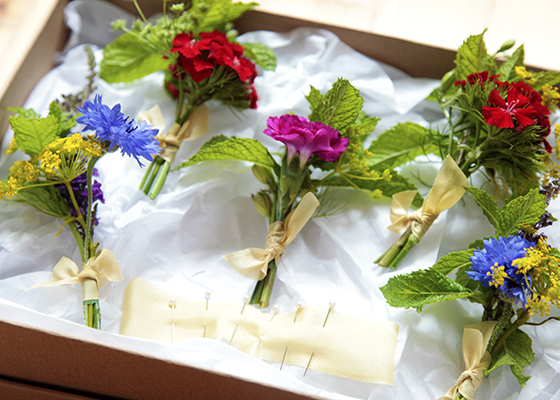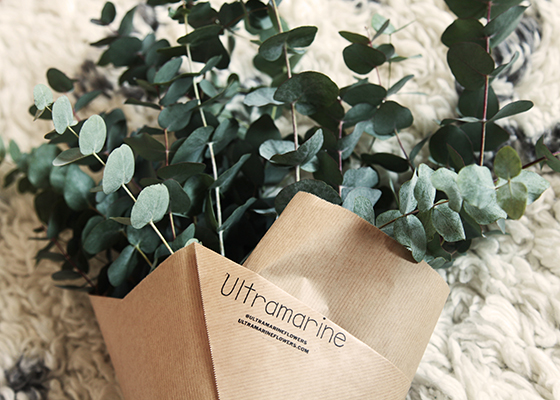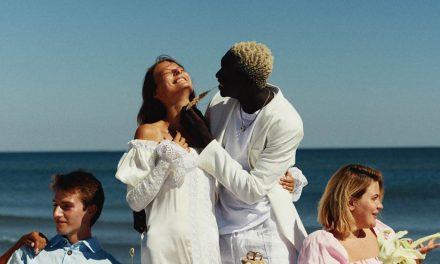A Guide To Choosing Seasonal Wedding Flowers
Flowers are a crucial part of any wedding. However they are also the most energy intensive and wasteful aspect. Gemma Therese Pearce of Ultramarine Flowers shares her guide to choosing seasonal and sustainable wedding flowers.
What Makes Flowers Sustainable?
The influence of seasonal and sustainable flowers has been steadily growing for many years. Around the globe, florists and couples alike have come to realise that blooms that are not only in season, but, ideally also grown locally, have a more positive impact on the environment. Local and seasonal flowers are grown without nasty chemicals and pesticides. They aren’t flown across the world causing air pollution and don’t produce the colossal amount of waste that mass-produced overseas flowers often do.
Whatever your taste or style of wedding, each season provides an abundance of flowers that can perfectly complement your vision of your big day. Gemma Therese Pearce, founder of Ultramarine Flowers has compiled this guide to help you discover what flowers and foliage are available to you. And to inspire you to look closer to home when planning your big day.
Exploring The Seasons
Spring: March 1st – May 31st
I love springtime. The sun finally starts to make an appearance, the days are longer and the first British flowers start to bloom. Some of my all time favourites are available during these months. Show stopping ranunculus are always a winner, they’re as frilly as roses and peonies and they continue to grow as they age. Ranunculus are available in a range of colours. From whites to brilliant yellows, fiery reds, both soft and hot pinks and deep, dark purples, making them a great flower for a huge range of colour palettes.
Another fab focal flower is the beautifully papery Icelandic poppy. These come in a striking colour spectrum of punchy pinks, yellows, peaches and whites. However they have very fragile petals so work best in bud vases on a table rather than a bouquet or buttonhole. For something visually similar but less delicate, the anemone is a great fancy flower and a popular choice for bridal bouquets. Anemones are also available in a broad spectrum of colours including; white, pastels and rich jewel tones such as plum and violet. They enjoy a long vase life meaning you can continue to enjoy them after the wedding day is over.
Spring is a great time to choose a yellow colour palette. Traditional daffodils, sweetly scented narcissi, ‘royal yellow’ irises and tulips are all in bloom in strong sunny shades. Lastly, British grown tulips are super special with many unusual varieties to choose from. With unique features like double petals, frilly edges or the super parrot variety that feel luxurious and their bendy stems create beautiful movement and shape within bouquets.
Summer: June 1st – August 31st
We are really spoilt for choice during the summer months, with an abundance of colours, romantic shapes and lush textures to choose from. Big, blousy peonies are enduringly popular but do have an incredibly short season. They are available in the traditional wedding colours of white, pink and coral and look wonderful in bridal bouquets. Another classic summer wedding flower is the rose. A far cry from imported lacklustre stems, British grown roses have a luxurious quality and spark a romantic mood. Garden style roses have a wonderfully traditional yet fresh feel and create an amazing aroma.
Summer flowers come in such a fantastic range of colours from the more traditional bridal whites, blues and mauves, to pretty pinks, rich reds and buttercup yellows. So many in fact, it can be hard to narrow down just one colour for this season.
Autumn: Sept 1st – Nov 30th
Despite being a less traditional time for a wedding, an Indian summer is the perfect setting to complement the rich colourscapes and great variety of British blooms available during these months. The main focal flower for autumn has got to be the dahlia. They steal the show in bridal bouquets and work brilliantly in larger arrangements such as flower arches and floating clouds. Full of character, they come in differing varieties from the pillowy petals of a creamy café au lait to the pom pom ball-headed jowey linda. Spanning the colour spectrum from soft peach and apricots tones and blush pinks, to autumnal orange and velvet crimsons, the dahlia works in most wedding schemes during the Autumn.
As the season draws to a close, it’s a great time to focus on a foliage heavy wedding scheme as there is plenty of British greenery available to you. Scented rosemary and silvery senecio would both work well in bouquets and buttonholes, and popular eucalyptus is also fab in large scale arrangements.
Winter: Dec 1st – Feb 28th
Although not traditionally thought of as peak time for British blooms, there is plenty of beauty in locally grown flowers and foliage during the wintertime. Embrace the festive season with deep green glossy ivy foliage alongside clusters of red berries that provide strong pops of rich colour peppered with pretty white snowdrops that look really magical. Another option could be to opt for a snow white palette by having only light and pearly flowers. Bright white anemones, paperwhites, viburnum and white marvel tulips create an immaculate, striking effect and sculptural, long stems of pussy willow are perfect for larger arrangements.










Trackbacks/Pingbacks